


GEORGE WASHINGTON
1732 -
ELECTED FIRST PRESIDENT OF THE UNITED STATES 1789 (G3b)
xxxxxAs
we have seen (1776 G3a),
at the end of the War of American Independence in 1783 George
Washington retired as commander-
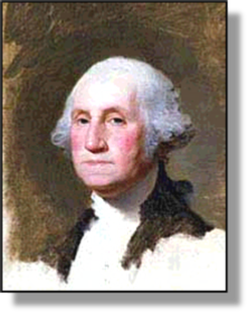 xxxxxAs we have seen (1776
G3a), the soldier George Washington played a leading and
vital role in the War of American Independence. When
it came to an end in 1783, he retired as commander in chief, but
before doing so, he saw the need to send a letter to all the states
urging them to agree to and support the establishment of a strong
central authority. He then returned to his home at Mount Vernon,
anxious to put his estate in good order, but from here, too, he
continued to plead for an “indissoluble union”, constantly fearing
that the country was about to slide into anarchy. Evidence to support
this possibility came in 1786 with the outbreak of Shay’s Rebellion in
Massachusetts. This convinced many Americans, including Washington,
that the Articles of Confederation were in urgent need of amendment,
if not replacement. Thus, as we have seen, in 1787,
as one of the delegates from Virginia, he attended the Philadelphia
Convention, summoned to draw up a form of federal Government that was
“adequate to the exigencies of the Union”. Not surprisingly, he was
chosen to preside over the proceedings.
xxxxxAs we have seen (1776
G3a), the soldier George Washington played a leading and
vital role in the War of American Independence. When
it came to an end in 1783, he retired as commander in chief, but
before doing so, he saw the need to send a letter to all the states
urging them to agree to and support the establishment of a strong
central authority. He then returned to his home at Mount Vernon,
anxious to put his estate in good order, but from here, too, he
continued to plead for an “indissoluble union”, constantly fearing
that the country was about to slide into anarchy. Evidence to support
this possibility came in 1786 with the outbreak of Shay’s Rebellion in
Massachusetts. This convinced many Americans, including Washington,
that the Articles of Confederation were in urgent need of amendment,
if not replacement. Thus, as we have seen, in 1787,
as one of the delegates from Virginia, he attended the Philadelphia
Convention, summoned to draw up a form of federal Government that was
“adequate to the exigencies of the Union”. Not surprisingly, he was
chosen to preside over the proceedings.
xxxxxDespite many
difficulties, over the next four months the Convention hammered out
and put down on paper its first draft of the American constitution.
Ratified the following year, this republican and federal form of
government safeguarded the rights of each state but, at the same
time, provided a central Congress (made up of the House of
Representatives and the Senate) to maintain law and order, defend
the new nation, and preserve the liberties of its individual
citizens. As was to be expected George Washington was elected
unanimously as the first president of the new state -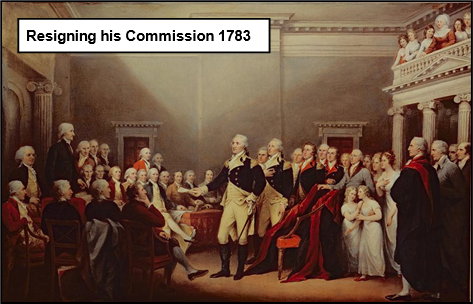 e
much preferred to go home and look after his estate!
e
much preferred to go home and look after his estate!
xxxxxOn his journey to New York, then the nation’s capital, and in the city itself, he was given a rousing reception. On the last day of April 1789 he took the oath of office on the balcony of Federal Hall, close to the where his statute stands today in Wall Street. Once sworn in, he quickly put his own stamp of authority on this high office. He rented good properties in both New York and Philadelphia, dressed in black velvet for formal occasions, and, accompanied by four resplendent liveried outriders, travelled in a coach drawn by a team of four or six horses. After much debate as to the title he should adopt, he was happy with the simplest form of address: The President of the United States.
xxxxxIn his inaugural
speech, he cautiously avoided identifying himself with the various
factions within government and, once in office, made a nation-
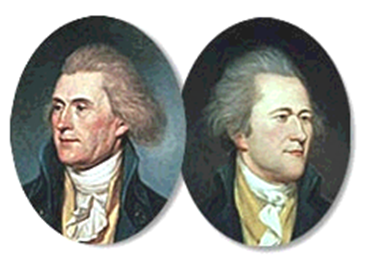 xxxxxFor the first few years, despite favouring the policies
put forward by Hamilton, Washington managed to tread an impartial
line between the rival political factions. But this balancing trick
between President and Congress, deftly performed with dignity and
propriety by Washington, could not be maintained indefinitely.
During his second term of office, beginning in 1792, new problems
arose, and he became subject to much criticism. By now, the two
parties had become firmly established and looking for a fight. There
was no shortage of flashpoints. First and foremost, the two parties
became bitterly divided over the French Revolution. In 1793 Thomas
Jefferson resigned as Secretary of State, opposed to Washington’s
strict policy of neutrality towards France, and his support for
Hamilton’s fiscal policy. There followed the Whisky Rebellion of
1794, a revolt by the farmers of western Pennsylvania against an
excise tax which had been levied by Hamilton and supported by the
president. There was no bloodshed, and the rebels were pardoned, but
Washington was again accused of favouring the Federalists. And in
the same year came Jay’s treaty with Great Britain, whereby trade
links were re-
xxxxxFor the first few years, despite favouring the policies
put forward by Hamilton, Washington managed to tread an impartial
line between the rival political factions. But this balancing trick
between President and Congress, deftly performed with dignity and
propriety by Washington, could not be maintained indefinitely.
During his second term of office, beginning in 1792, new problems
arose, and he became subject to much criticism. By now, the two
parties had become firmly established and looking for a fight. There
was no shortage of flashpoints. First and foremost, the two parties
became bitterly divided over the French Revolution. In 1793 Thomas
Jefferson resigned as Secretary of State, opposed to Washington’s
strict policy of neutrality towards France, and his support for
Hamilton’s fiscal policy. There followed the Whisky Rebellion of
1794, a revolt by the farmers of western Pennsylvania against an
excise tax which had been levied by Hamilton and supported by the
president. There was no bloodshed, and the rebels were pardoned, but
Washington was again accused of favouring the Federalists. And in
the same year came Jay’s treaty with Great Britain, whereby trade
links were re-
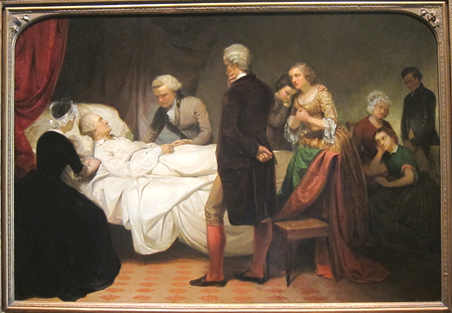 xxxxxIt was because of this vitriolic abuse on the part of
his political opponents -
xxxxxIt was because of this vitriolic abuse on the part of
his political opponents -
xxxxxDespite the political
turmoil of his second period in office, when Washington retired in
March 1797, the country’s finances were in a more stable condition,
and both political parties had come to accept, in principle at
least, the need for a strong federal government. Over the next
seventy years or so the number of states was to increase from 13 to
36, and the new nation was to grow considerably in size, population
and wealth. But quite apart from the inevitable social and economic
problems to be faced, two major issues were to loom large on the
American stage during this period. One was the precise balance of
power which was to be struck between the individual states and
Congress. The other was the extent to which the institution of
slavery should be permitted to develop -
xxxxxIncidentally, New York served as the capital of the United States
from 1785, but the seat of the
nation’s government remained at Philadelphia, where it had been
situated since 1776. In 1791 President George Washington selected a
site for a new capital city at the confluence of the Potomac and
Anacostia rivers, close to the centre of the original thirteen
colonies. First known as Federal City, but then named Washington
after the nation’s first president, it was opened as the new capital
and seat of government in 1800. It is situated in the federally
owned District of Columbia -
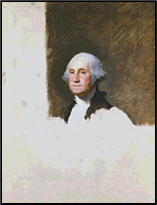
xxxxx……
Thexportrait of Washington above was
painted by the brilliant American artist Gilbert
Stuart (1755-
Acknowledgements
Washington: by
the American portrait painter Gilbert Stuart (1755-
Including:
Jean-
Houdon

xxxxxAfter a visit to Mount
Vernon in 1785, the brilliant French sculptor, Jean-
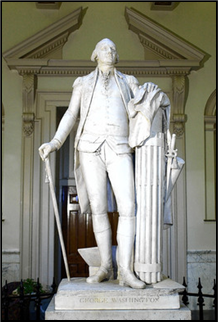 xxxxxThe Frenchman Jean-
xxxxxThe Frenchman Jean-
xxxxxBorn in Versailles of
humble parents, his remarkable skill as a sculptor was evident by
the age of nine. He attended the art and sculpture school at the
Royal Academy, along with his fellow countryman Jean Baptiste
Pigalle, and won the Prix de Rome for sculpture in 1761. On
returning to Paris in 1771 he struck up a friendship with the French
encyclopedist Denis Diderot, and produced a bust of him in 1775.
Diderot introduced him to many of the rich and famous, and this
brought in the commissions. His patrons included Catherine the Great
of Russia, Benjamin Franklin, the German 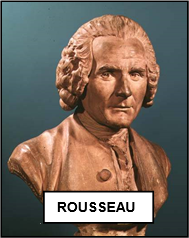 composer
Christoph Willibald Gluck, and the French philosophers Jean Jacques
Rousseau and Voltaire. The bronze bust of Rousseau, now in the
Louvre, Paris, was developed from a cast of his face, taken by
Houdon a short while after the philosopher died in 1778. And it was
three years later that Houdon exhibited his famous seated figure of
Voltaire.
composer
Christoph Willibald Gluck, and the French philosophers Jean Jacques
Rousseau and Voltaire. The bronze bust of Rousseau, now in the
Louvre, Paris, was developed from a cast of his face, taken by
Houdon a short while after the philosopher died in 1778. And it was
three years later that Houdon exhibited his famous seated figure of
Voltaire.
xxxxxHoudon’s portrait
sculpture is remarkable above all for its vitality and realism,
which capture not simply the likeness but also the very character of
his sitter. He would first produce his subject in clay, and then
work in plaster, bronze or marble, showing a remarkable sensitivity
and technical skill in all three mediums. Apart from portraiture -

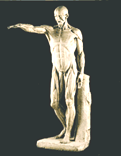 xxxxxIncidentally, when Houdon was
studying in Rome in the 1760s he made a close study
of muscles, attending medical dissection to perfect his knowledge.
As a result he produced a sculpture to demonstrate the anatomical
structure of a man. Known as Écorché (the
man with no skin), it made his name. Plaster castes were made of the
figure and these became widely used in art schools as anatomical
models -
xxxxxIncidentally, when Houdon was
studying in Rome in the 1760s he made a close study
of muscles, attending medical dissection to perfect his knowledge.
As a result he produced a sculpture to demonstrate the anatomical
structure of a man. Known as Écorché (the
man with no skin), it made his name. Plaster castes were made of the
figure and these became widely used in art schools as anatomical
models -
xxxxx……
Axnoted Parisian
sculptor at this time was Augustin Pajou (1730-
G3b-


